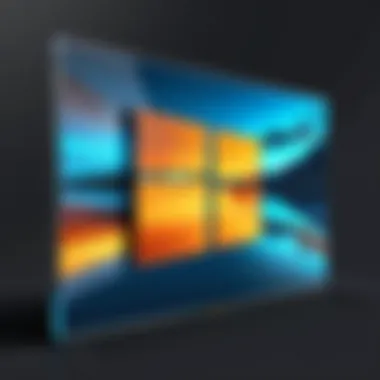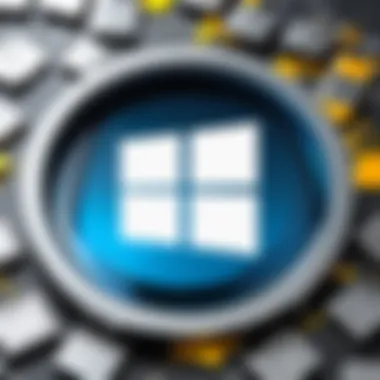Understanding the Cost of Windows 10 Product Key


Intro
The cost of a Windows 10 product key is a subject that attracts both scrutiny and curiosity among IT professionals and technology enthusiasts. It encompasses various aspects such as the type of key, pricing models, and the nuances that differentiate genuine product keys from unauthorized ones. Understanding these factors can empower users to navigate the purchasing process with confidence. In this guide, we will explore these components in detail, providing a thorough analysis that aids in decision-making regarding software purchases.
Features Overview
Key Specifications
Windows 10 product keys come in different types, each tailored for specific use cases. The primary types include:
- Retail Keys: These are full licenses that one buys from authorized retailers. They are transferable to another computer.
- OEM Keys: These keys are tied to the hardware they are installed on. They usually come pre-installed on new devices and do not allow transfer to different machines.
- Volume Licenses: Designed for organizations, these keys allow multiple activations and are usually less expensive when purchased in bulk.
Unique Selling Points
The differentiation in pricing comes from various selling points:
- Transferability: Retail keys offer flexibility, a unique advantage for users planning to upgrade hardware.
- Support: Retail purchases often come with customer support from Microsoft, adding value to the investment.
- Security and Authenticity: Purchasing from authorized channels reduces the risk of counterfeit keys, ensuring compliance with Microsoft's licensing agreements.
Factors Influencing Cost
Several elements can affect the price of Windows 10 product keys. Understanding these can clarify why prices vary significantly in the market.
- Source of Purchase: Authorized sellers typically offer more stability in pricing, while unauthorized sellers may lure customers with lower prices but higher risk.
- Type of Key: As previously mentioned, the differences between retail, OEM, and volume keys contribute to variations in cost.
- Local Market Conditions: Pricing can also be influenced by currency fluctuations and local economic factors.
"Understanding these differences is crucial for making informed purchasing decisions."
Implications of Unauthorized Purchases
Buying from unauthorized resellers may seem appealing due to lower prices, but it comes with risks. These include:
- Lack of Support: Unauthorized products usually lack official customer support.
- Potential for Activation Issues: Keys might end up being invalid or blocked after purchase.
- Legal Concerns: Purchasing counterfeit keys can expose users to potential legal ramifications.
Culmination
Navigating the landscape of Windows 10 product key pricing requires dedication and awareness of the various factors at play. By grasping the distinctions between types of keys and the risks involved in purchasing from unauthorized sources, users can make sound decisions that align with their technical needs and compliance requirements. This understanding not only supports personal usage but also ensures a solid foundation for organizations investing in software solutions.
Overview of Windows
Windows 10 represents a significant shift in Microsoft’s approach to operating systems. This article will lay out not just the necessity of understanding Windows 10, but also its implications for the cost of product keys. As organizations and individuals increasingly rely on technology, having the right operating system becomes crucial not merely for functionality but also for security and user experience.
Prologue to Windows
Windows 10, released in July 2015, has become one of the most popular operating systems globally. Its user interface, robust features, and enhanced security settings make it appealing to a vast array of users. Particularly, for IT professionals and businesses, understanding the operational capabilities of Windows 10 can provide a competitive advantage. This version marked the end of the traditional upgrade cycle; instead, Windows 10 operates on a service model, ensuring users always benefit from the latest updates.
Key Features of Windows
Windows 10 brings several crucial features that enhance its usability and effectiveness:
- Start Menu: A return to the familiar Start Menu combines the traditional layout with modern live tiles.
- Cortana: Microsoft’s virtual assistant integrates with various applications, providing quick voice search and task management.
- Windows Ink: This feature offers enhanced support for touch and stylus devices, particularly beneficial for designers.
- Universal Apps: Windows 10 includes universal applications that work across various devices like PCs, tablets, and phones, promoting a seamless experience.


Understanding these features is vital when assessing the value and necessity of a product key.
Evolution from Previous Versions
The transition from Windows 7 and Windows 8/8.1 to Windows 10 has been noteworthy. Windows 10 not only addresses numerous user complaints regarding previous iterations, but it also introduces functional improvements. For instance, users complained about the intrusive updates in Windows 8. Through Windows 10, Microsoft has refined its update process, ensuring smoother and more user-friendly functionality. The evolution of this operating system showcases Microsoft's response to user feedback and industry changes, therefore emphasizing the relevance of investing in a Windows 10 product key.
Understanding Product Keys
Understanding product keys is a vital aspect of engaging with Windows 10. These keys serve as unique identifiers that ensure the software is authentic and properly licensed. Each key is tied to a specific version of Windows, which can prevent piracy and unauthorized use. This topic highlights the importance of compliance with licensing agreements, as failing to use legitimate product keys can lead to various complications, including software instability and legal issues.
The advantages of understanding product keys extend to the financial side as well. Knowledge of the different types of keys allows users to make informed purchasing decisions, potentially saving them money while acquiring the correct version that meets their needs. This comprehension can also help in distinguishing between various purchasing channels, emphasizing the dangers associated with unauthorized resellers.
What is a Product Key?
A product key is a 25-character code that is used to activate the Windows operating system. It is essential for confirming the authenticity of the software. Simply put, it is a form of proof that the software has been legally purchased. A unique code ensures that the operating system is installed on the right number of devices, adhering to the terms of the license agreement.
When a computer is first set up, entering this product key is a necessary step in the installation process. It validates the software and enables users to access all features fully. Without it, the system may operate in a limited capacity with incessant reminders to activate.
Types of Windows Product Keys
Different types of Windows 10 product keys exist, each serving unique purposes and target audiences. They can be categorized into several groups, including retail keys, OEM keys, and volume licensing keys. Understanding the differences between these types is crucial for determining which option best fits your situation.
Retail Keys
Retail keys are purchased directly by consumers through authorized sellers. This type remains one of the most known among users. A significant characteristic of retail keys is their flexibility; they can be transferred from one device to another, provided that the original device is no longer using the key. This trait makes retail keys a popular choice for individuals upgrading their machines or switching between devices.
The unique feature of retail keys is that they come with full customer support from Microsoft, enhancing user confidence. However, retail keys tend to be pricier compared to other options, sticking to the features they offer. Users must weigh the benefits of mobility and support against the higher cost.
OEM Keys
OEM keys are typically bundled with hardware components, like a new laptop or desktop, directly from the manufacturer. The key is tied specifically to the first device it activates. This aspect makes OEM keys less flexible than retail keys, as they cannot be transferred to another computer without violating the licensing terms.
The main selling point for OEM keys is their lower price, which is attractive for budget-conscious consumers. However, the drawback lies in the lack of direct support from Microsoft. Instead, users must rely on the manufacturer for support, which can vary in quality. Users benefit from the lower initial cost but should be cautious of the reduced flexibility.
Volume Licensing Keys
Volume licensing keys are designed for organizations that need to activate multiple copies of Windows quickly and efficiently. They are ideal for businesses, educational institutions, and government agencies. One key allows for the software to be installed on numerous machines, making it a cost-effective solution for large-scale deployments.
The main characteristic of volume licenses is their centralized management, which can simplify administration and maintenance. However, these keys have restrictions; they are generally not available for personal use. Organizations must adhere to strict rules, leaving little room for misuse. The advantages include considerable cost savings for larger organizations, though it may not suit individual users.
Understanding the types of product keys is crucial for making informed decisions in your Windows 10 purchase.
Factors Influencing the Cost of Windows Product Keys
Understanding the costs associated with Windows 10 product keys is essential for making informed acquisition decisions. Pricing does not exist in a vacuum. It reflects broader market dynamics, the structure of keys, and geographic considerations. Recognizing the various elements that influence these costs can help IT professionals and tech enthusiasts optimize their purchasing strategies.
Retail vs OEM Pricing Structures
The structure of product keys can significantly affect their pricing. Retail keys are typically more expensive than OEM keys. Retail versions are sold directly to consumers and come with certain benefits, such as full support and easier transferability between machines. In contrast, OEM keys are generally tied to the first computer they are installed on. They do not allow for easy transfer and often come with limited support.


Retail keys may average around $139, while OEM keys can range significantly lower, averaging as low as $100. This price difference can be crucial for organizations looking to install Windows 10 on multiple machines. Understanding these distinctions can guide consumers toward a choice that aligns with their needs and budget.
Regional Pricing Variations
Prices for Windows 10 product keys can also vary significantly by region. One factor is local purchasing power. In countries where average incomes are lower, Microsoft adjusts its pricing to make its product more accessible. For example, a Windows 10 key could cost $200 in the U.S. but only about $150 in part of Asia.
These pricing variations can lead to a phenomenon known as "grey market" sales. Consumers in higher-priced areas may purchase keys from regions where they are cheaper. While this may result in short-term savings, the long-term implications and potential legal issues should not be underestimated. Furthermore, understanding regional variances helps in strategizing license acquisition across different locations.
Availability and Demand
Finally, availability and demand play critical roles in pricing. If many users seek to acquire Windows 10 quickly, the prices tend to increase. This happens often during product launches or promotional periods. Supply chain issues can further complicate this, leading to shortages and inflated prices in certain regions.
Conversely, when there is a surplus of keys, or if demand drops, such as when a new version of Windows is released, prices may decrease. Keeping an eye on market trends and understanding the general demand can provide strategic advantages. It can help in planning purchases to take advantage of lower prices.
"Knowledge of market dynamics and product structures empowers better purchasing choices."
The Role of Resellers
Resellers play a crucial role in the ecosystem surrounding Windows 10 product keys. Their influence can significantly affect pricing dynamics, availability, and purchasing experiences for consumers. Understanding this role is essential for IT professionals and technology enthusiasts as it directly impacts their decisions regarding software acquisition. Resellers can be classified into two main categories: authorized and unauthorized. Each category presents its own set of advantages and drawbacks which should be considered carefully.
Authorized Resellers
Authorized resellers are officially recognized by Microsoft to sell Windows 10 product keys. These resellers follow strict guidelines and comply with the licensing agreements set forth by Microsoft. By purchasing from authorized resellers, buyers can ensure that they receive genuine product keys along with support for any activation issues.
Benefits of purchasing from authorized resellers include:
- Genuine Product Keys: You can be assured that the product key you obtain is legitimate and will function correctly with your version of Windows 10.
- Customer Support: In case of any issues during installation or activation, authorized resellers offer customer support, which can be essential for IT specialists handling multiple installations.
- Warranty Options: Some authorized resellers may provide warranties for their product keys. This offers peace of mind regarding the reliability of the software.
It is advisable for buyers to verify a reseller's authorization status before making a purchase. This can often be done through the reseller's website or by directly contacting Microsoft.
Risks of Unauthorized Purchases
While competitive pricing can be tempting, purchasing Windows 10 product keys from unauthorized sources poses significant risks. Often, these sources may sell counterfeit or invalid product keys, leading to installation failures or future deactivation.
Potential risks associated with unauthorized purchases include:
- Invalid Keys: Many unauthorized sellers may provide keys that have already been activated, making them useless for the buyer. This results in wasted time and financial loss.
- Lack of Support: If you encounter issues with an unauthorized product key, you will likely not have access to any customer service or support. This can lead to prolonged frustrations in resolving activation problems.
- Security Vulnerabilities: Buying from dubious sources may expose you to security risks. Some unauthorized vendors may offer keys bundled with malware or spyware, compromising your system’s integrity.
- Legal Implications: Using invalid keys can violate licensing agreements, exposing buyers to potential legal repercussions.
"Always opt for authorized resellers to avoid headaches and ensure that your Windows installation is secure and legitimate."
Analyzing Windows Product Key Pricing
When analyzing Windows 10 product key pricing, several key elements deserve attention. First, one must look at the prevailing market prices for different types of keys. These vary based on the source, whether it be authorized resellers or unauthorized ones. Second, a comparative analysis of purchase options helps clarify which avenue offers the best value. Finally, discounts and promotions can significantly affect total expenditures, providing opportunities for cost savings.
By breaking down each of these factors, buyers can better understand their purchasing options and avoid costly mistakes. The cumulative effect of these considerations directs buyers toward the most economical choices while ensuring compliance with licensing agreements.
Current Market Prices
Current market prices for Windows 10 product keys fluctuate regularly. These fluctuations can be attributable to numerous factors, including supply chain issues, demand variations, and regional pricing strategies. As of now, retail keys typically range from $139 to $199, while OEM keys can be found for as low as $100. Notably, these prices do not account for any potential discounts or promotions from specific sellers, which can affect the final amount.


When exploring current prices, it’s important to verify them from multiple sources. Authorized resellers, such as Microsoft Store and Newegg, often provide reliable pricing. In contrast, unauthorized sellers may offer keys for significantly lower rates, but the risk of encountering counterfeit products is high. It's advisable to conduct thorough market research before making any purchase to ensure authenticity.
Comparative Analysis of Purchase Options
A critical aspect of purchasing Windows 10 product keys lies in evaluating available options. Retail keys are generally more expensive but offer better support and upgrade paths. They can be transferred between machines, providing flexibility if a user chooses to change their hardware. Conversely, OEM keys are tied to the first device they activate on and lack transferability. Buyers need to acknowledge these differences in functionality when considering their options.
Beyond retail and OEM keys, there are also numerous third-party sellers. While some may offer legitimate products, others might not adhere to proper licensing. Thus, comparing not only price but also credibility of the seller is essential. IT professionals should favor reputable retailers to safeguard against issues that may arise from unauthorized purchases.
Discounts and Promotions
Discounts and promotions abound in the market for Windows 10 product keys, particularly during seasonal sales or major technology events. Not infrequently, authorized retailers offer limited-time promotions that can reduce the cost by as much as 30% or more. Particularly around back-to-school seasons, Black Friday, and other holidays, these options can present significant savings opportunities.
It is crucial to not only monitor these promotions but also to be aware of the terms associated with them. Some discounts may apply only to specific editions or can require membership in certain programs. Customers should read the fine print to avoid unfavorable surprises after their purchase.
"Identifying the right time to purchase Windows 10 product keys can yield substantial savings. Awareness of sales cycles is beneficial."
Purchasing Considerations
When it comes to acquiring a Windows 10 product key, careful consideration is crucial. This section will dissect several vital aspects of purchasing that IT professionals and tech enthusiasts should bear in mind. Understanding your needs and recognizing long-term costs is imperative for ensuring not only a successful transaction but also optimal functionality for your systems.
Evaluating Your Needs
Assessing your specific requirements is paramount in the decision-making process. It begins with a clear understanding of how Windows 10 fits into your current and future projects or tasks. Are you looking for a key for personal use, or will you need multiple licenses for an organization?
Review your existing software and hardware environment. Compatibility is essential. Evaluate whether you need additional features that may only be available with specific editions of Windows 10, such as Pro or Enterprise. Consider factors like:
- User Experience: What will be the primary use? Gaming, software development, or basic computing?
- Scale of Deployment: Will you need multiple keys, and what pricing options do they offer?
- Future Scalability: Will the chosen version meet changing requirements in the future?
By contemplating these aspects, you can significantly narrow down the choices regarding which product key to purchase.
Assessing Total Cost of Ownership
The total cost of ownership (TCO) encompasses more than just the initial price of the product key. It is vital to consider the long-term expenses associated with using Windows 10. These often include:
- Upgrades and Updates: Windows frequently releases updates that improve security and functionality. Will the chosen key provide access to these updates?
- Technical Support: When buying from authorized resellers, support might be included, which can offset potential troubleshooting costs.
- Training and Familiarization Costs: Depending on your team's expertise, there may be costs associated with training staff on the new operating system.
- Renewals and Licenses: For enterprise environments, consider how licenses may need to be renewed and the costs associated with that.
Calculating the TCO will provide clarity on whether the chosen Windows 10 product key aligns with your budget in both the short and long term. By combining evaluations of both immediate needs and long-lasting costs, you ensure that your investment is sound.
"Purchasing software is not merely about the upfront price. The total cost of ownership often reveals the real financial impact of your choices."
Culmination
Summary of Key Points
- The distinction between retail and OEM keys offers insights into available options. Retail keys are generally more expensive but provide flexibility.
- Regional pricing variations reflect economic factors and demand in different markets. It is prudent to consider local pricing when purchasing.
- The role of authorized resellers should not be underestimated, as they offer legitimate channels for purchasing product keys. This helps avoid unauthorized purchases, which can lead to legal issues and compromised software security.
Final Considerations for IT Professionals
For IT professionals, evaluating the cost of Windows 10 product keys is more than a simple monetary transaction. It involves understanding the long-term implications of software licensing and its impact on organizational operations. Considerations include:
- Total Cost of Ownership (TCO): Assess the upfront cost alongside potential future expenses related to updates and support costs.
- Licensing Compliance: Ensure that any key purchased adheres to the licensing agreements, as non-compliance can lead to legal penalties.
- Future Scalability: Consider the organization's growth potential and choose a licensing model that aligns with future expansion needs.
Understanding these facets can prepare IT professionals to make choices that not only satisfy immediate needs but also support organizational objectives in the long run.
The landscape of software acquisition continues to evolve. Keeping up with current trends and understanding the implications of each type of key will contribute significantly to strategic decision-making within the tech landscape.



